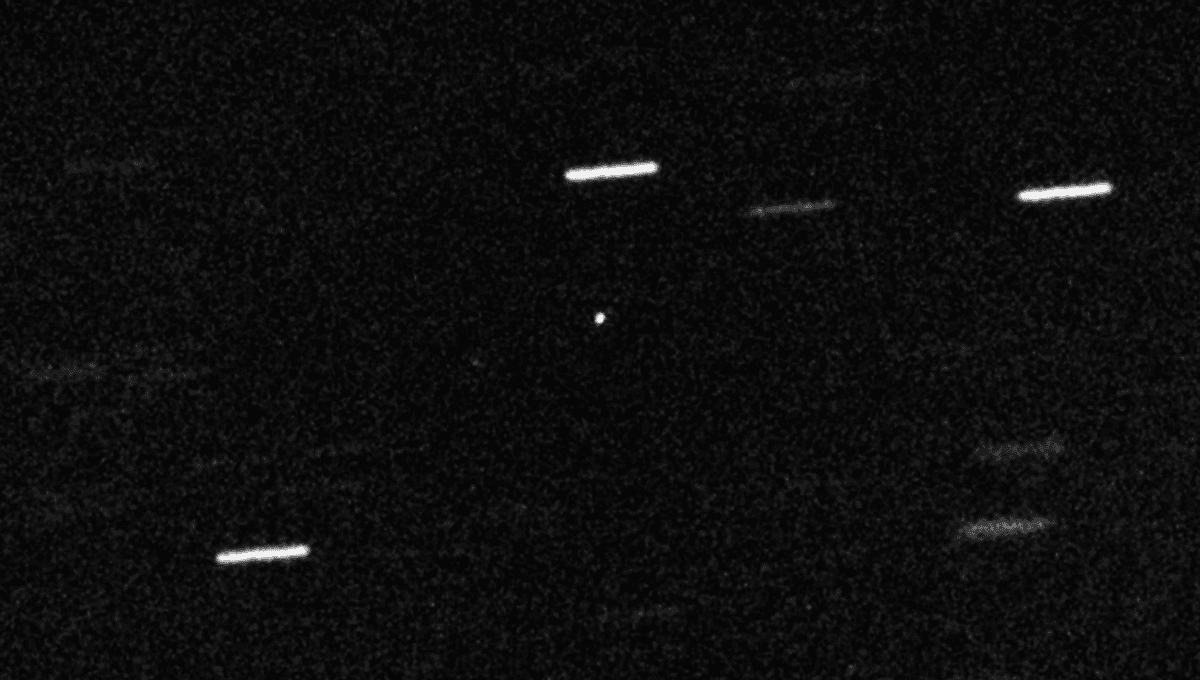
In 2017, astronomers at the Pan-STARRS1 observatory looking for near-Earth asteroids spotted an object as it hurtled past our Sun at 38.3 kilometers per second (23.8 miles per second).
Soon, telescopes around the world pointed in the unusual object’s direction, trying to capture as much data as they could before it moved away from the Sun. Looking at visible light reflecting off the object, scientists were able to determine its size and shape, finding it is around 400 meters (1,300 feet) long, and likely shaped like a pancake.
The speed and trajectory of the object A/2017 U1 suggested that it did not come from our Solar System, and that it will leave our Solar System again. ‘Oumuamua, as it is now called, was our first confirmed interstellar visitor.
One thing that puzzled scientists about the object was that it underwent non-gravitational acceleration as it passed through the Solar System, meaning that the acceleration it underwent could not be explained only by gravitational forces acting upon it. While this led some, including Harvard’s controversial astronomer Avi Loeb, to speculate that ‘Oumuamua could be an alien spaceship or probe producing its own thrust, a lot more likely explanations have been proposed.
The real puzzle for astronomers was not the acceleration itself. As comets get close to the Sun and heat up, they outgas, losing gas and dust, which form their trail or coma. This outgassing acts like thrusters, slightly altering the trajectory, rotation, and speed of the comet. Outgassing could explain ‘Oumuamua’s acceleration, but no coma was observed, and its shape is unusual for a comet.
In 2023, a team came up with a solution: ‘Oumuamua is a water-rich planetesimal, which lost hydrogen from its surface as it headed through our Solar System.
“A comet traveling through the interstellar medium basically is getting cooked by cosmic radiation, forming hydrogen as a result. Our thought was: If this was happening, could you actually trap it in the body, so that when it entered the solar system and it was warmed up, it would outgas that hydrogen?” Jennifer Bergner, assistant professor of chemistry at UC Berkeley and co-author on the paper, said in a statement. “Could that quantitatively produce the force that you need to explain the non-gravitational acceleration?”
Research conducted in the 20th century showed that when high-energy particles like cosmic rays hit icy bodies, molecular hydrogen (H2) is produced and trapped within the ice.
“For a comet several kilometers across, the outgassing would be from a really thin shell relative to the bulk of the object, so both compositionally and in terms of any acceleration, you wouldn’t necessarily expect that to be a detectable effect,” Bergner continued. “But because ‘Oumuamua was so small, we think that it actually produced sufficient force to power this acceleration.”
The object is likely an interstellar planetesimal, which lost hydrogen in its encounter with our Sun, altering its velocity. Another study in 2017 hinted that this could have been the object’s first encounter with a star.
“The heliocentric incoming velocity of ‘Oumuamua in right-handed Galactic coordinates is v∞(U, V, W)=(−11.2, −22.4, −7.6) km s−1. This is remarkably close to the mean motion of stars in the solar neighborhood, with an especially small deviation from the mean in U and W,” the team explained in their paper.
“Younger stars have smaller velocity dispersions than older systems, so this close proximity to the exact local mean velocity suggests an origin in a young stellar system, although the possibility that ‘Oumuamua has been orbiting the galaxy for billions of year cannot be ruled out. This encounter has transformed ‘Oumuamua’s orbit from one that is particularly close to the local mean to one that is typically dispersed from the mean, hinting that this may be its first close approach to a star, and its first chance to lose volatiles.”
There have been challenges to the hydrogen explanation, however, with physical chemist Niels Ligterink proposing that “modelling, laboratory and theoretical results show that it is unlikely that sufficient H2 can be produced in ‘Oumuamua to accelerate it if the object largely consisted of H2O ice”.
“This implies that there must be another or additional driver of ‘Oumuamua acceleration,” he wrote in a Matters Arising response to the 2023 study, “or the object has a very unusual ice composition and is substantially older (>500 Myr) than postulated”.
However, he postulated that if the object is substantially older than assumed and contains (for example) methanol, there might be a big enough yield to produce the observed acceleration once degassing began.
Responding to Ligterink, the team noted that “it is clear that additional experimental efforts are necessary to explore trends in H2O radiolysis for, for example, thicker ices and over longer timescales. However, the extant experimental data do not convincingly prove that higher H2 yields cannot occur in astrophysical settings,” adding that experiments have found higher yields (of around 35 percent) were generally consistent with the uncertainties.
“We agree that when modelling the behaviour of ‘Oumuamua, it is important to consider factors such as its age and received energy dose, as well as the ice-phase H2 formation rate and possible maximum yields,” the team wrote in reply. “Ultimately, the model presented in our paper can explain ‘Oumuamua’s non-gravitational acceleration with assumptions for the age, composition and H2 content of the body that are compatible with existing experimental and observational constraints.”
Studying the object closer could tell us more about young stellar systems. Unfortunately, it is now out of range of our existing telescopes, and so a probe would be needed to study it in more detail. Such a mission – dubbed Project Lyra – has been proposed to do just that, perhaps sling-shotting past Jupiter and gaining gravitational acceleration.
Source Link: What Caused Our First Interstellar Visitor's Non-Gravitational Acceleration?